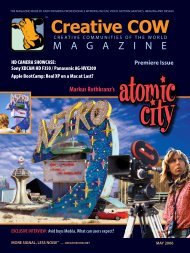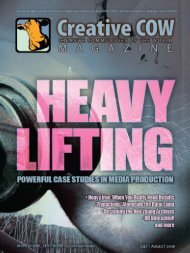Read the COW Magazine Online - Creative COW Magazine
Read the COW Magazine Online - Creative COW Magazine
Read the COW Magazine Online - Creative COW Magazine
You also want an ePaper? Increase the reach of your titles
YUMPU automatically turns print PDFs into web optimized ePapers that Google loves.
SIDEBAR: DISTRIBUTION FORMATS<br />
The concept that you expose <strong>the</strong> entire full aperture frame,<br />
but only extract a portion of it for <strong>the</strong> release prints may be a<br />
stretch for videographers who are so used to what-you-see-iswhat-you-get<br />
framing. But it is important to remember that<br />
<strong>the</strong> shooting format of film is now completely separate from<br />
<strong>the</strong> format it is projected in a <strong>the</strong>ater. The digital intermediate<br />
process has completely solidified this by allowing you to create<br />
numerous deliverables at many different aspect ratios and<br />
frame sizes, starting with a single frame of a single size.<br />
No matter how a film is projected, whe<strong>the</strong>r by a film print<br />
or a digital projector, all <strong>the</strong> same issues with framing and aspect<br />
ratios remain <strong>the</strong> same.<br />
ficult, given <strong>the</strong> fact that composition is usually driven<br />
by <strong>the</strong> amount of “head room” given to <strong>the</strong> actors. It is<br />
much more aes<strong>the</strong>tically pleasing to use what is called<br />
common top framing. This groups all <strong>the</strong> different soft<br />
mattes near <strong>the</strong> top of <strong>the</strong> frame.<br />
Ano<strong>the</strong>r example of protected framing is what you<br />
see anytime you watch HD television networks. They<br />
are shooting 16:9 protected for 4:3, or sometimes 14:9,<br />
which gets letterboxed for 4:3 audiences. The result is<br />
that all action needs to fit inside <strong>the</strong> 4:3 safe region, inside<br />
<strong>the</strong> 16:9 frame. Graphic elements like lower thirds<br />
and scoreboards end up all crowded into <strong>the</strong> center of<br />
<strong>the</strong> frame.<br />
Two-shots that would o<strong>the</strong>rwise be framed properly<br />
are now strangely wide, so that <strong>the</strong> audience watching<br />
<strong>the</strong> 4:3 center cut doesn’t get chopped off heads. This<br />
gives you a 16:9 frame with strangely ill-composed and<br />
vacant sides (wings), but again, it is all about multiple<br />
distribution channels.<br />
With one broadcast, you can (somewhat) satisfy <strong>the</strong><br />
HD 16:9 audience and <strong>the</strong> 4:3 audience at<br />
<strong>the</strong> same time. Some networks compromise<br />
by allowing a wider 14:9 protected<br />
frame inside a 16:9 image. They <strong>the</strong>n chop<br />
off <strong>the</strong> 14:9 sides and letterbox this for<br />
<strong>the</strong> 4:3 audience. The letterbox area is reduced,<br />
and <strong>the</strong> 16:9 framing is much better<br />
composed.<br />
When Super 35 is scanned for digital<br />
intermediate, <strong>the</strong> entire frame is usually<br />
included (a full aperture scan). This means<br />
that matte boxes, boom mics, dolly tracks<br />
and o<strong>the</strong>r set materials end up inside <strong>the</strong><br />
1.33 frame, but are cropped out later.<br />
This allows film editors <strong>the</strong> option of<br />
re-framing <strong>the</strong> shot vertically as <strong>the</strong>y have<br />
additional image to work with. It also provides<br />
additional image for visual effects work such as 3D<br />
camera tracking.<br />
FLAT AND SCOPE<br />
Today, with <strong>the</strong> exception of specialty formats like IMAX,<br />
<strong>the</strong>re are two types of film prints sent to <strong>the</strong>aters: Academy<br />
Flat and Anamorphic Scope. There is also a plethora<br />
of digital projection formats commonly referred to as<br />
DCI (Digital Cinema Initiative), but <strong>the</strong>y still adhere to <strong>the</strong><br />
same aspect ratios as film formats.<br />
Academy Flat usually has an aspect ratio of 1.85:1<br />
(1.66:1 and 1.75:1 are obsolete), while Anamorphic Scope<br />
has a 2.39 aspect ratio when projected on screen. When<br />
a <strong>the</strong>atrical trailer is released, it will be formatted to fit<br />
both Scope and Flat to match <strong>the</strong> feature presentation,<br />
so that <strong>the</strong> projectionist doesn’t need to switch lenses<br />
between <strong>the</strong> two.<br />
Because <strong>the</strong> frames are so close toge<strong>the</strong>r on anamorphic<br />
scope film, it was decided in <strong>the</strong> 70s to reduce<br />
<strong>the</strong> height of <strong>the</strong> frame, giving more room to better hide<br />
<strong>the</strong> splices. Then, in 1993, SMPTE (Society of Motion Picture<br />
Television Engineers) tweaked <strong>the</strong> standard again,<br />
to make it <strong>the</strong> same width as Academy Flat, and <strong>the</strong> aspect<br />
ratio became 2.39:1. The standard today is officially<br />
2.39:1, although this is sometimes rounded off to 2.40:1.<br />
There are even more factors to consider after a movie’s<br />
run in <strong>the</strong>aters, with cuts for DVD and Blu-ray, cable,<br />
airlines, iTunes and more. Home video releases, due to<br />
taller aspect ratios, may even show more of <strong>the</strong> vertical<br />
image than you would have seen in <strong>the</strong> <strong>the</strong>ater, taking<br />
advantage of <strong>the</strong> soft matted areas of <strong>the</strong> original camera<br />
negative.<br />
In <strong>the</strong> end, <strong>the</strong>re are many ways to see a film today,<br />
all of <strong>the</strong>m with different screen dimensions, aspect ratios<br />
and so on. Where you see <strong>the</strong> film makes all <strong>the</strong> difference<br />
as to what aspect ratio you see. My 5-year old kid<br />
watches movies on my iPhone and he is perfectly happy<br />
with that.<br />
As mentioned earlier, “Avatar” was presented in <strong>the</strong><br />
format that best fit <strong>the</strong> screen of <strong>the</strong> particular <strong>the</strong>ater<br />
you saw <strong>the</strong> movie. James Cameron was said to prefer<br />
<strong>the</strong> taller screens (1.43 and 1.78) for <strong>the</strong> stereoscopic presentations,<br />
and <strong>the</strong> 2.35 scope version for <strong>the</strong> 2D presentations.<br />
Directors today are not always shooting for one<br />
aspect ratio. They may be shooting with 2.35 in mind,<br />
but protecting for 1.85 or even 1.78. These pressures to<br />
frame for different aspect ratios are driven by <strong>the</strong> needs<br />
to create different deliverables for different markets and<br />
applications.<br />
The most dramatic example of this is Pan and Scan,<br />
which was outlawed by <strong>the</strong> Geneva Convention in 1949.<br />
Well, okay…maybe it wasn’t, but it should have been.<br />
This inhumane process simply chops off <strong>the</strong> sides of <strong>the</strong><br />
widescreen image to fit a 4:3 TV screen, trying to capture<br />
<strong>the</strong> action by moving <strong>the</strong> image from side-to-side.<br />
With <strong>the</strong> obsolescence of 4:3 televisions, this practice has<br />
been all but abandoned.<br />
Or has it? The process can also be applied to a 2.35<br />
or 1.85 master to make it fit into a 16:9 Television screen.<br />
That’s exactly what you need to do if you take a movie<br />
framed for 1.85 and make a 2.35 version and make a 2.35<br />
trailer for it. So, you see, pan and scan to a certain degree<br />
will always be around.<br />
Since <strong>the</strong> widescreen format wars were first “settled”<br />
over 100 years ago, it turns out that nothing stays<br />
settled for long — which is why <strong>the</strong> only way to avoid<br />
bluffing is to keep learning.<br />
n<br />
Get Both DVDs for <strong>the</strong> Price of One!<br />
Because you are a <strong>Creative</strong> <strong>COW</strong> <strong>Magazine</strong> subscriber, we have a special offer<br />
just for you. Get both of our newest Final Cut training DVDs, yes, two top-selling<br />
DVDs for $49 (USA + shipping/handling). That’s a 2-for1 special! Usually, <strong>the</strong>se<br />
great titles sell for $49 each. But if you enter “Cowmag” as your code, you will<br />
be charged just $49 for <strong>the</strong> two newest <strong>Creative</strong> <strong>COW</strong> Master Series DVDs.<br />
Use Code “Cowmag” for 2-for-1 @ www.creativecow.net/cowmag<br />
32 The Asset Management and Distribution Issue — <strong>Creative</strong> <strong>COW</strong> <strong>Magazine</strong><br />
<strong>Creative</strong> <strong>COW</strong> <strong>Magazine</strong> — The Asset Management and Distribution Issue 33










